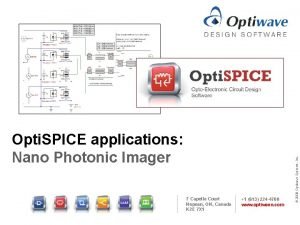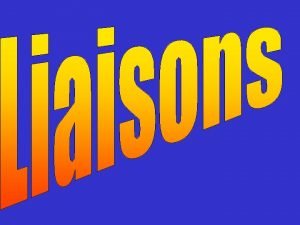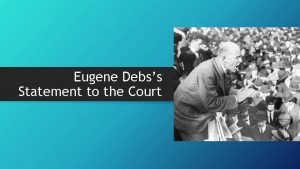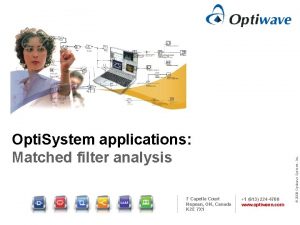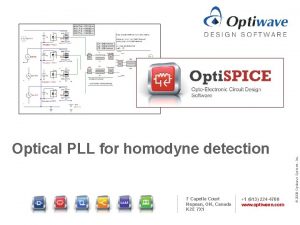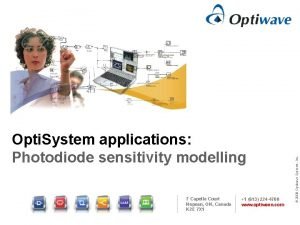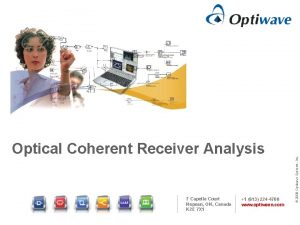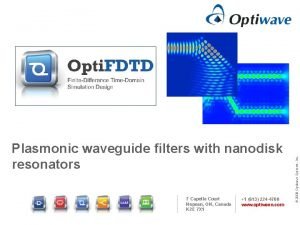7 Capella Court Nepean ON Canada K 2






- Slides: 6

7 Capella Court Nepean, ON, Canada K 2 E 7 X 1 +1 (613) 224 -4700 www. optiwave. com © 2009 Optiwave Systems, Inc. Opti. System applications: Signal quality ratios

Introduction § Signal quality ratios When designing or analyzing the performance of an analog or digital link, the following signal metrics are commonly used: § § Carrier to noise ratio (C/N) Noise power density (No) Energy per bit to noise density (Eb. No) Energy per symbol to noise density (Es. No) § C/N is calculated from the ratio of the carrier power to the noise level over the specified bandwidth of the transmission system. It is used to assess the quality of the analog communication channel (the signal that is used to carry the digitally modulated information envelope). § Eb. No and Es. No are, respectively, the ratios of the energy per information bit and symbol divided by the noise power density. They are frequently used to measure and compare the performance of digital modulation links. § The following application note briefly describes how to capture and measure C/N, No, Eb. No and Es. No for a typical QAM modulation system REFS [1] “Digital Transmission: Carrier-to-Noise Ratio, Signal-to-Noise Ratio, and Modulation Error Ratio”, White Paper (Cisco Systems & Broadcom Corp), 2006 [2] “Signal-to-Noise, Carrier-to-Noise, Eb. No”, Wolfgang Damm (Dir. of Product Marketing), Noisecom. http: //www. noisecom. com/resource-library/webinars/sn-cn-ebno-webinar ; accessed 23 June 2017 [3] “Intuitive Guide to Principles of Communications: Link Budgets”, 1998/2002 Charan Langton, http: //complextoreal. com/wp -content/uploads/2013/01/linkbud. pdf ; accessed 20 June 2017 2

Design setup § The example design below represents a 16 QAM digital modulation scheme transmitted over a 20 GHz electrical carrier signal. The signal metrics for C/N, No (power spectral density), Eb. No and Es. No are calculated using the Component script of the electrical power meter (EPM) An electrical filter is used to account for measurement system/channel bandwidth The received carrier power and noise is captured with an electrical power meter. The signal metrics are then calculated and reported as custom results 3

Signal quality metric calculations This part of the component script is used to access the global parameter settings The VBScript below is associated with the EPM Visualizer and is used to calculate the signal quality metrics based on the measured carrier power and measured noise power The receiver bandwidth is accessed from the parameter “Bandwidth” of the Rect Filt component The local results for Signal Power and Noise Power are accessed here. As there is a pre-filter before the EPM, the power is integrated over the filter bandwidth (represents the measurement system bandwidth) C/N Ratio = Carrier power/Noise power PSD (No/2) = Noise Power/Receiver Bandwidth. The PSD model in Opti. System uses a complex signal representation (+/- frequencies). To account for the negative frequencies (1/2 of noise spectrum), the calculated value for the noise density is reduced by 3 d. B. Es. No = C/N x Receiver Bandwidth/Symbol Rate Eb. No = C/N x Receiver Bandwidth/Bit Rate As the receiver bandwidth is set to the symbol rate (5 GHz) Es. No will equal C/N 4

RFA (1): Signal and noise power analysis Carrier power Carrier to Noise ratio Noise power C/N ~ 44 d. B The C/N calculation here is for the total integrated signal power and noise power over 5 GHz BW. As the Signal and noise spectrum are relatively flat there is a close match between OSA measurements and the component calculation (43. 8 d. B) Es. No and C/N are identical as the system bandwidth and symbol rate are both at 5 GHz. 5

RFA (2): PSD analysis To verify the PSD, select the check box for Power spectral density under the Graphs tab of the RFA Post. Filt visualizer (the Y-axis units will change to d. Bm/Hz). The PSD in Opti. System assumes the double-sided noise convention and thus a factor of -3 d. B is applied to the PSD calculation for the EPM component script. Note: The resolution bandwidth of the spectrum analyzer will change the position of the noise floor. For the case below it was un-selected to match the sampling rate of the simulation. PSD ~ -204 d. Bm/Hz PSD calculation is adjusted by 3 d. B to account for double side band noise representation 6
